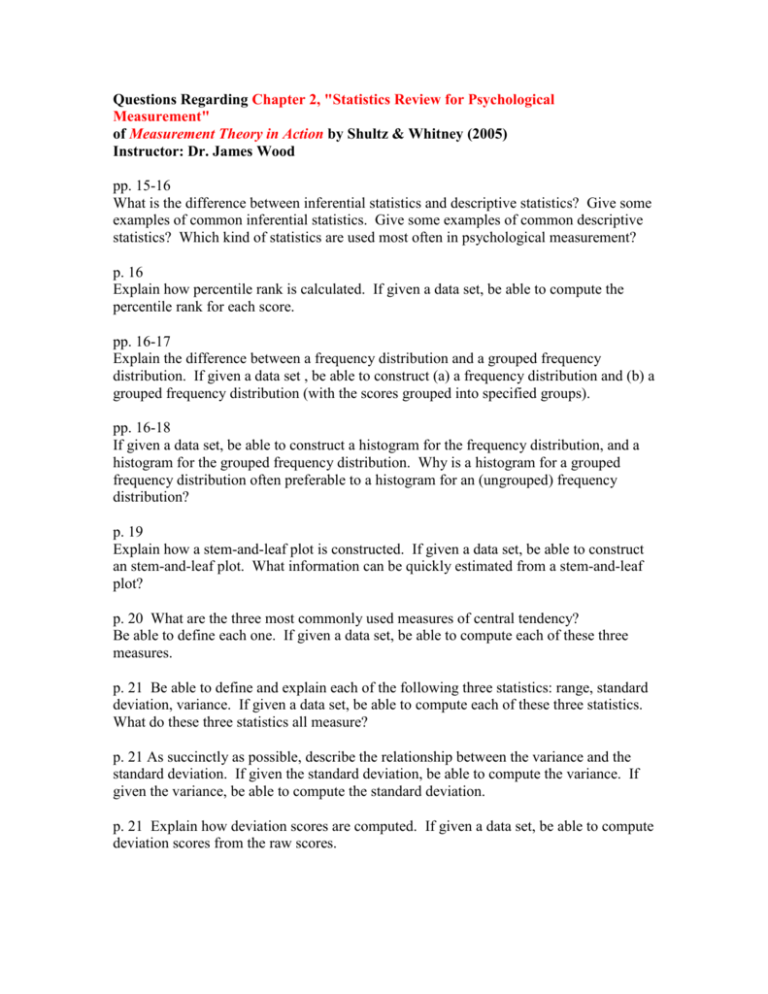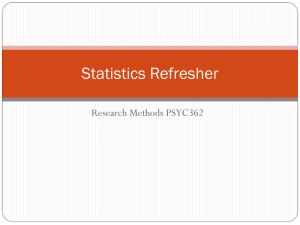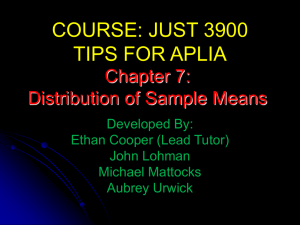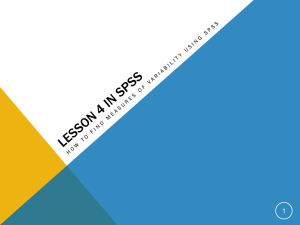Module 2: Statistics Review for Psychological Measurement
advertisement

Questions Regarding Chapter 2, "Statistics Review for Psychological Measurement" of Measurement Theory in Action by Shultz & Whitney (2005) Instructor: Dr. James Wood pp. 15-16 What is the difference between inferential statistics and descriptive statistics? Give some examples of common inferential statistics. Give some examples of common descriptive statistics? Which kind of statistics are used most often in psychological measurement? p. 16 Explain how percentile rank is calculated. If given a data set, be able to compute the percentile rank for each score. pp. 16-17 Explain the difference between a frequency distribution and a grouped frequency distribution. If given a data set , be able to construct (a) a frequency distribution and (b) a grouped frequency distribution (with the scores grouped into specified groups). pp. 16-18 If given a data set, be able to construct a histogram for the frequency distribution, and a histogram for the grouped frequency distribution. Why is a histogram for a grouped frequency distribution often preferable to a histogram for an (ungrouped) frequency distribution? p. 19 Explain how a stem-and-leaf plot is constructed. If given a data set, be able to construct an stem-and-leaf plot. What information can be quickly estimated from a stem-and-leaf plot? p. 20 What are the three most commonly used measures of central tendency? Be able to define each one. If given a data set, be able to compute each of these three measures. p. 21 Be able to define and explain each of the following three statistics: range, standard deviation, variance. If given a data set, be able to compute each of these three statistics. What do these three statistics all measure? p. 21 As succinctly as possible, describe the relationship between the variance and the standard deviation. If given the standard deviation, be able to compute the variance. If given the variance, be able to compute the standard deviation. p. 21 Explain how deviation scores are computed. If given a data set, be able to compute deviation scores from the raw scores. p. 21 It seems that the computation of the standard deviation involves unnecessary work. First one squares the deviation scores. Then one averages these squared deviation scores. Then one "un-squares" the average (by taking the square root). Explain what would happen if you did not square the deviation scores in the first place, before adding them p. 22 Explain what a Z score is. If given a data set, be able to compute Z scores from the raw scores. p. 22 A Z score is computed as a fraction. What is put in the numerator of the fraction? What is put in the denominator? p. 22 What "rule of thumb" do Shultz and Whitney suggest for determining whether a particular score is an "outlier"? Why is it useful to identify outliers? p. 22 What is meant by "skewness"? What is meant by "positive skewness"? What is meant by "negative skewness"? If shown a frequency distribution for a data set, be able to tell immediately whether it is positively skewed, negatively skewed, or not skewed. Be able to describe how a frequency distribution can point to the left or to the right, and be able to explain the relationship between this "pointing" and skewness. p. 22 If given some basic information about a frequency distribution, be able to estimate whether the distribution is skewed. For example, if a distribution contains several outliers with Z scores greater than 3.0 but no outliers with Z scores less than 3.0, is the distribution positively skewed, negatively skewed, or not skewed? p. 22 You do NOT need to pay any attention to the formula for skewness. However, if given a number (such as -.626) be able to say (a) whether the number represents extreme positive skewness, moderate positive skewness, no skewness, moderate negative skewness, or extreme negative skewness. pp. 22-23 You do not need to pay any attention to what the book says about kurtosis. This topic will be covered (if at all) in lecture. p. 23 What is the difference between a univariate statistic and a bivariate statistic? p. 23 Be able to state, word-for-word, the definition of criterion that appears in the glossary of Shultz and Whitney. p. 24 What is the statistic that is most commonly used to describe the relationship between a test score and a criterion? p. 25 What is a scatter plot? If given a data set of two variables, be able to construct a scatter plot that depicts their relationship. pp. 23-26 What are homoscedasticity and heteroscedasticity? If you were shown a scatter plot based on two variables, how would you go about determining whether the data points exhibit homoscedasticity and heteroscedasticity? pp. 23-26 Given a data set of two variables, be able to compute (a) the raw deviation scores for both variables , (b) the standardized deviation scores (Z-scores) for both variables, (c) the variances and standard deviations of the raw deviation scores, (d) the variances and standard deviations for the Z-scores, (e) the covariance of the raw deviation scores (dividing by n-1), and (f) the covariance of the Z-scores (dividing by n rather than n-1). The covariance of the Z-scores is equal to what other number? p. 26 Why do we calculate univariate and bivariate descriptive statistics for our test scores and criteria? pp. 26-27 Quickly read through the discussion of estimation and confidence intervals. At this point in the course, it is not necessary to spend much time on these topics or on the related calculations. pp. 28-29 Read Case Study 2.1, "Descriptive Statistics for an Introductory Psychological Statistics Test." Be prepared to answer the following three questions from page 29: (1) What additional descriptive statistics should Rudy have run to try to make sense of the exam data? (2) How could Rudy have used the additional questionnaire data to help make sense of the test scores? (3) What statistics could Rudy calculate to determine if there really were any "significant differences" between the two laboratory sections?







